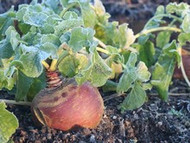How To Grow Swede
Swede is one of the easiest vegetables to grow and is well-suited to the novice gardener. They also crop over a very long time because they can be left in the soil throughout the winter.
Swede is often confused with turnips but they have several advantages over the turnip. Firstly, they crop much later in the season and swede is well capable of withstanding very hard frosts. In addition, the swede is sweeter and milder. As the name implies, swede originated from Sweden and they are related to the turnip. They are also known as rutabagas.
Swedes are grown in most cases purely for the tasty edible roots but it's also possible to leave the root in the ground and eat the green leaves which will appear in the spring. Just cook them as you would for spring greens. There are three types of swede and they are known as green tops, bronze tops and purple tops. Purple tops produce the largest crops and are the most commonly available.
Where to Grow
Swedes prefer a medium soil which contains lots of nutrients although they will be happy growing in most soil types. They are unfortunately prone to club root so make sure the soil is not too acidic. Acid soils encourage club root. The ideal pH for swedes is somewhere between 7.0 and 7.4. If the soil is short of nutrients then add some well-rotted manure a month or so prior to sowing seed. If manure is not available then add a long lasting fertiliser such as bonemeal or similar.
Swedes don't like being waterlogged. If your soil is not free draining then either dig in some well-rotted compost or grow them on a ridge so that the water drains away.
When to Grow
The best time to sow swede in most areas is mid May to mid June but if your area is warm postpone sowing to mid July.
Transplanting
Seeded or transplanted swede should be spaced 6 inches between plants in the row with rows 1 foot apart.
Make a hole with a dibber or suitable stick (A piece of an old broom handle is ideal). Place the seedling plug in the hole and firm gently around the roots, water well.
They should be planted slightly deeper than they grew in the seed bed.
Crop Care
The seedlings will take about 10 days to emerge. Thin the seedlings out to about 25cm (10in) apart. Keep them well-watered and well-weeded and you should have no problems
Pests and diseases
Aphids Curled leaves and twisted stems with lots of green black or bluish insects on the leaves and stems
Gall Weevil White maggots appear from the top part of the roots
Downy Mildew Grey patches of mildew will appear with the leaves wilting
Slugs and Snails The leaves will have holes in them and you may well notice the typical slimy trail of these pests
Flea Beetle These normally go for the young seedlings of the will leave round holes.
Wireworms Small tunnels through the roots.
Club Root Disease The leaves will droop and the roots will be distorted.
Harvesting
Your swedes will be large enough for harvesting in early autumn. But if you leave them in the ground until the odd frost or two has got to them then they will taste much sweeter.
Swedes store well. Place them in a box with layers separated by sand or store them in a sack. Store them in a cool area out of light.
Storage
If you harvest your swedes, store them in a dry, dark and cool area of the garden, in a wooden crate or some similar device that rats and mice cannot access. Only harvest during dry weather or the swedes will rot. Also remove leaves and root tails to discourage rot if storing. Indoor storage can be as easy as placing in a hessian sack or layering them in a box filled with sand. Again, the area should be cool, dark and dry. Swedes will keep for up to 6 months if stored correctly.

